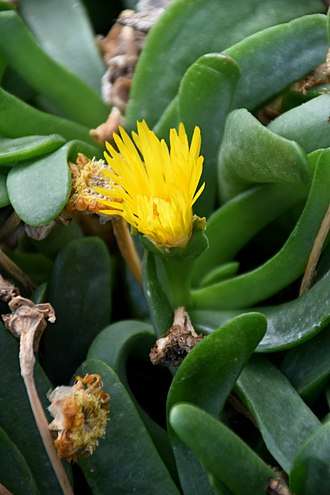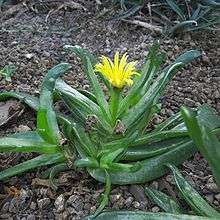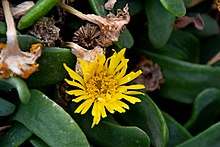Glottiphyllum longum
Glottiphyllum longum is a species of succulent plant in the family Aizoaceae, native to the Western Cape and Eastern Cape Provinces, South Africa.
| Glottiphyllum longum | |
|---|---|
| The strap-shaped leaves of Glottiphyllum longum | |
| Scientific classification | |
| Kingdom: | |
| (unranked): | |
| (unranked): | |
| (unranked): | Core eudicots |
| Order: | |
| Family: | |
| Genus: | |
| Species: | Glottiphyllum longum (Haw.) N.E.Br. |
It is the most widespread Glottiphyllum species, and the most common one in cultivation.
Description



It can be distinguished from its relatives by the way that its flat, green, fleshy, tongue-shaped leaves are all born in two opposite rows (distichous), lying flat and mostly prostrate along the ground.
The long leaves are distinctively strap-shaped, with rounded margins. Sometimes they are also mildly curved or upturned at the tips, but not hooked. The bladder cells at the leaf margins are oriented horizontally and not elongated.
The fruits are born on long stalks. The seed capsules have 9 or more locules and persist on the stem for many years. The seeds are very small and smoothed on the sides.
Distinction from G. depressum
This species is sometimes confused with the similarly widespread Glottiphyllum depressum. However the flowers and fruits of G.depressum do not have long stalks and are therefore held closely against the stem. Its seed capsule also has a very soft, spongy base, and the whole capsule degrades and falls away soon after releasing its seed. The top of the seed capsule has very thick, raised valves in a tall dome, which is surrounded by a low inconspicuous rim.
In contrast, the flowers and fruits of G. longum are on long stalks, and remain on the plant for a long time.
The leaves of G.longum are also often longer. G.depressum has more clearly hooked depressions on its leaves, which are also often slightly more erect. The cell walls of its leaves' bladders cells are undulated.
Distribution
This is the most widespread and common species in the entire genus Glottiphyllum. It occurs in shrubby thicket, on loamy-sandy soil, from near Ceres in the west, throughout the Little Karoo and Overberg regions, as far as the Albany region of the Eastern Cape. Here, in the far eastern part of its range, it co-occurs with the species that it also most resembles, its close relative Glottiphyllum grandiflorum.[1]
| Wikispecies has information related to Glottiphyllum longum |
| Wikimedia Commons has media related to Glottiphyllum longum. |
Synonyms
- Glottiphyllum cultratum (Salm-Dyck) N.E.Br.
- Glottiphyllum davisii L.Bolus
- Glottiphyllum erectum N.E.Br.
- Glottiphyllum latum N.E.Br.
- Glottiphyllum latum N.E.Br. var. cultratum (Salm-Dyck) N.E.Br.
- Glottiphyllum longum (Haw.) N.E.Br. var. hamatum N.E.Br.
- Glottiphyllum longum (Haw.) N.E.Br. var. heterophyllum (Haw.) G.D.Rowley
- Glottiphyllum obliquum (Willd.) N.E.Br.
- Glottiphyllum propinquum N.E.Br.
- Glottiphyllum pustulatum (Haw.) N.E.Br.
- Glottiphyllum uncatum (Haw.) N.E.Br.
- Mesembryanthemum adscendens Haw.
- Mesembryanthemum angustum Haw. var. heterophyllum Haw.
- Mesembryanthemum cultratum Salm-Dyck
- Mesembryanthemum latum Haw.
- Mesembryanthemum linguiforme auct.
- Mesembryanthemum linguiforme L. var. adscendens (Haw.) A.Berger
- Mesembryanthemum linguiforme L. var. cultratum (Salm-Dyck) A.Berger
- Mesembryanthemum linguiforme L. var. depressum (Haw.) A.Berger
- Mesembryanthemum linguiforme L. var. longum (Haw.) A.Berger
- Mesembryanthemum linguiforme L. var. obliquum (Willd.) A.Berger
- Mesembryanthemum linguiforme L. var. pustulatum (Haw.) A.Berger
- Mesembryanthemum linguiforme L. var. uncatum (Haw.) A.Berger
- Mesembryanthemum longum Haw.
- Mesembryanthemum longum' Haw. var. uncatum Haw.
- Mesembryanthemum lucidum Haw.
- Mesembryanthemum medium Haw.
- Mesembryanthemum obliquum Willd.
- Mesembryanthemum pustulatum Haw.
- Mesembryanthemum pustulatum Haw. var. lividum Salm-Dyck
- Mesembryanthemum uncatum (Haw.) Salm-Dyck
References
- Heidrun E.K. Hartmann, Horst Gölling: A monograph on the genus Glottiphyllum (Mesembryanthema, Aizoaceae). In: Bradleya. Band 11, 1993, p.40